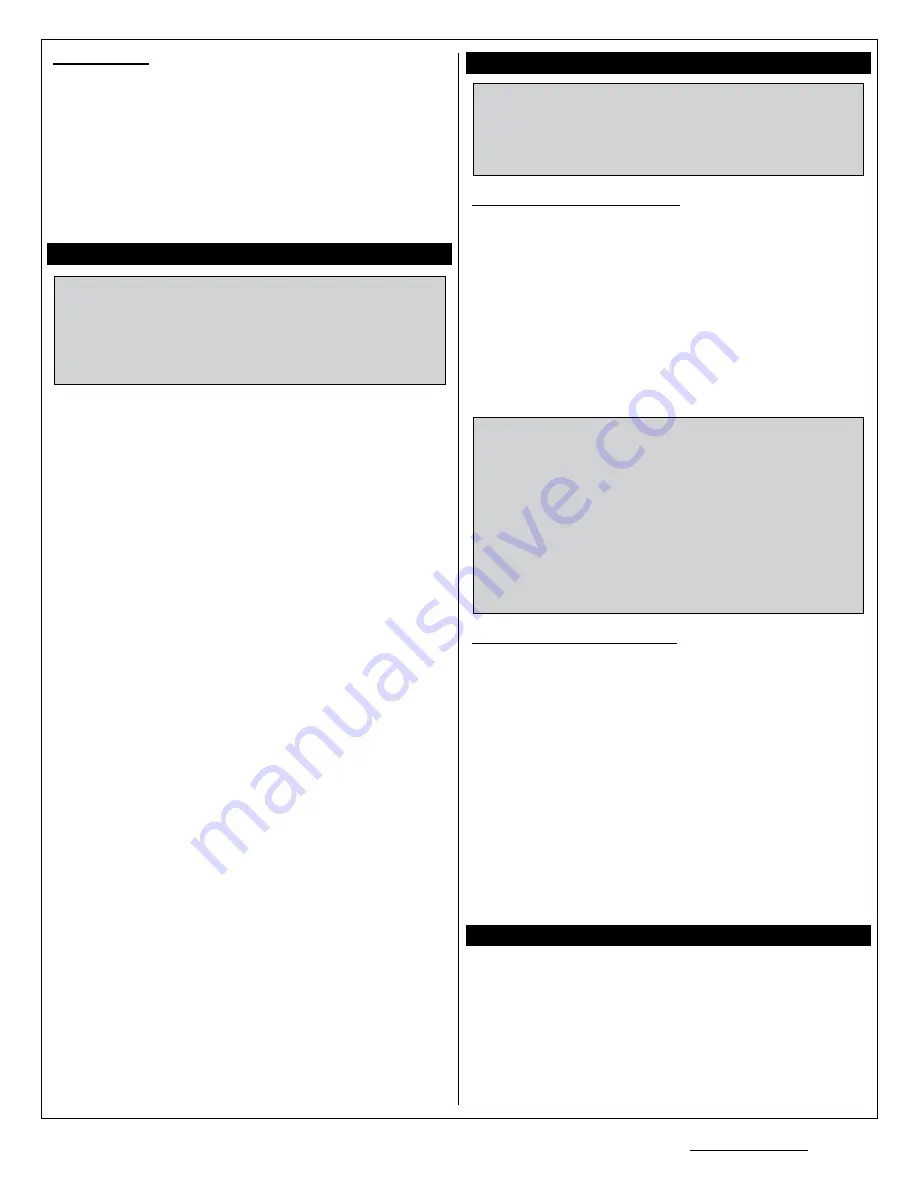
Global Services
l
18480 Bandilier Circle
l
Fountain Valley, CA 92708
l
Phone: (714) 963-0329
l
Fax: (714) 964-6236
l
Email: service@globalhobby.net
IMPORTANT
Your XLS series engine is an ABC engine. The cylinder
sleeve is tapered at the top, causing severe resistance when the piston
moves through the top of the stroke. This is normal. When the engine
heats up to operating temperature, this resistance will decrease and the
proper clearance will be achieved. The break-in procedure will guide you
through the steps necessary to properly break in your new ABC engine.
The break-in process allows the engine parts to perfectly fit each other
and properly protect each part from premature wear. The engine should be
broken in using the type of fuel recommended in the Fuel Recommendation
section on page 3.
Fuel containing only synthetic lubricants should not
be used during the break-in procedure.
For the break-in procedure we
recommend mounting the engine into the aircraft it will be used in. This way
the muffler, fuel tank and throttle linkage can all be tested in combination
with the engine. If your aircraft uses a cowl, it should be removed during
the break-in procedure.
q
1) Turn the high speed needle valve out 2-1/2 turns from the fully closed
position.
q
2) If you are using an electric starter to start the engine, follow the
procedure in the previous section on page 3. If you are starting the engine
by hand, follow that procedure in the previous section above.
q
3) Open the throttle barrel to approximately 1/4 throttle, then connect the
power to the glow plug. Start the engine using an electric starter or by hand.
If starting by hand you will need to vigorously flip the propeller through the
compression stroke several times before the engine will start.
q
4) Once the engine starts, open the throttle barrel to about 1/2 throttle.
You may need to lean the high speed needle valve in about 1/4 turn to keep
the engine running at half throttle.
q
5) After the engine has been running about 1 minute, remove the power
from the glow plug and slowly advance the throttle barrel to full throttle.
Adjust the high speed needle valve so that the engine is running very rich.
You should notice excessive white smoke coming from the exhaust. Let the
engine run for approximately 10 minutes then stop the engine.
q
6) Let the engine cool for approximately 10 minutes then restart it. Set
the high speed needle valve mixture to a slightly leaner setting, about 1/4
turn more in. Let the engine run for about 5 minutes at this setting, then stop
the engine and let it cool for approximately 10 minutes.
q
7) Repeat the procedure in step 6, while leaning the needle valve slightly
more each time. In all, you should run the engine about a total of 45 minutes
of actual running time. After 45 minutes of run-time the engine is ready
for flight. Fly the aircraft with the engine set as rich as possible, but with
adequate power to fly the aircraft. After each flight, lean the mixture slightly.
Continue to do this for about 5 flights. At this point the engine should hold a
good setting on the high speed needle valve and you can begin to fine tune
the needle valve settings to increase performance.
BREAK-IN PROCEDURE
Setting the High Speed Needle Valve
q
1) Start the engine and remove the power from the glow plug. Allow the
engine to warm up for about 30 seconds.
q
2) After the engine has warmed up, slowly lean the high speed mixture
until the engine reaches peak rpm. After reaching peak rpm, richen the
mixture slightly until an audible drop in rpm is heard. If you are using a
tachometer this should be between a 200~300 rpm drop.
q
3) With the engine running at full power, carefully lift the nose of the aircraft
about 45º into the air. The mixture should not become too lean, but you may
hear a slight increase in rpm. If the engine sags, or loses rpm when you
hold the nose up, the mixture is too lean. If this is the case, slightly richen
the mixture and follow the test once more.
IMPORTANT
Rpm will increase about 10%~30% in the air. This is
due to the forward motion of the aircraft as it is flying. Because of this,
more air is entering the carburetor, at a higher force, which causes the
mixture to lean out. Additionally, as the fuel level in the fuel tank goes
down, fuel draw becomes more difficult for the engine, especially during
aerobatics, thus causing the mixture to go lean. It is imperative that you
set the mixture rich while on the ground to compensate for the leaning
tendencies that will happen in the air. Always watch the exhaust during
your flight. The engine should leave a noticeable white smoke trail at all
times. If there is no smoke trail, the engine is running too lean. You should
land immediately and reset the mixture.
Setting the Low Speed Needle Valve
q
1) Start the engine and lean out the high speed needle valve as per the
previous steps. Close the throttle until the slowest
reliable
idle is reached.
Allow the engine to idle for about 15~20 seconds.
q
2) Quickly advance the throttle to full. If the engine just stops running as
soon as the throttle is advanced, the idle mixture is too lean. With the engine
stopped, richen the idle mixture about 1/8 of a turn.
q
3) Repeat steps 1 and 2 until the engine will transition from idle to full
throttle smoothly. Minor hesitation in the transition is normal.
q
4) If you quickly advance the throttle from idle to full and the engine seems
to be very rich during transition (i.e., lots of smoke coming from the exhaust),
the mixture is too rich. With the engine stopped, lean the idle mixture about
1/8 of a turn.
q
5) Repeat steps 1 and 4 until the engine will transition from idle to full
throttle smoothly. Minor hesitation in the transition is normal.
4
Starting by Hand
When starting the engine by hand always use a chicken stick or a heavy
leather glove. Never just use your bare hand or serious injury could result.
To make the engine easier to start by hand it should first be primed. This is
done by opening the throttle barrel completely and covering the tip of the
muffler with your finger. Fuel can then be drawn into the engine by 'pulling'
the propeller through the compression stroke 2-3 times. This will draw fuel
into the engine. After fuel begins to enter the carburetor, remove your finger
from the muffler and pull the propeller through the compression stroke once
to check for a hydro-locked condition.
WARNING
Be careful never to lean the engine out too much. Remember
that the lubricants for your engine are suspended in the fuel. If you lean out
the fuel mixture too much you will also be lowering the amount of lubricant
entering your engine. Less lubricant means more chance of your engine
overheating and possible engine failure.
OPTIMIZING THE MIXTURE SETTINGS
l
Avoid running the engine under dusty conditions. If you are in a dusty
environment we suggest using an air filter over the carburetor.
l
At the end of every flying day, purge the engine of fuel by disconnecting
the fuel line and allowing the engine to run dry of fuel.
l
Use a high quality after-run oil in the engine after you have purged the
engine of fuel. Inject the oil into the engine through the carburetor and through
the glow plug hole. Rotate the crankshaft several times to distribute the oil
throughout the engine. This will prevent the engine from forming rust.
BASIC ENGINE MAINTENANCE


























